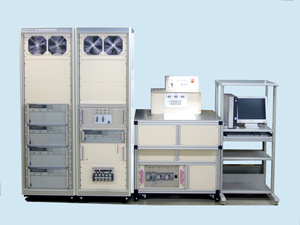



 |
 |
 |
 |
|

|
| Transition thermal resistance measuring instrument |
► The transition thermal resistance measuring instrument is a device that measures the transition thermal resistance such as IGBT/MOS-FET/Di/BJT.
- The BJT transition thermal resistance measuring instrument is a device by which a specified electric power is impressed between the collector emitters, the temperature of the chip is raised, and difference (ΔVBE) of the voltage between the base emitters by slight current (Im) before and behind that is requested. As a result, the thermal resistance of the sample can be guessed.
- The IGBT transition thermal resistance measuring instrument is a measuring instrument by which voltage difference (ΔVGE) between the gate emitters is requested as well as the BJT transition thermal resistance measuring instrument.
- The P-MOS FET transition thermal resistance measuring instrument is a measuring instrument by which voltage difference (ΔVGS) between the gate sources is requested as well as the BJT transition thermal resistance measuring instrument.
- ΔVF of the diode can be measured between the base emitters of the BJT transition thermal resistance measuring instrument.
■ Specifications
| Output voltage | 2 - 30/100/600/1200V |
| Output current | 0.1 - 30/100/200/500/1000A |
| Pulse width | 100,200,500uS 1,2,5,10,20,50,100,200,500mS 1S,2S,30S,DC |
| Measurement current (Im) | 1 - 99/199/999mA |
| Measurement range | ΔVbe: 999/1999mV MAX (where Vbe MAX: 3V) ΔVgs/Vge: 999/1999/9990mV (where Vgs/Vge MAX: 20V) |
| Sampling point | Td: 50 - 990uS |
■ There is a power restriction in the thermal resistance measuring instrument, and the area that can be measured according to a voltage, a current, and pulse width is limited. Moreover, the size and the weight of the device change greatly depending on the specification. As for the above-mentioned specification, detailed meeting is needed for design and production.
★ This specification is one example. Please inquire details.